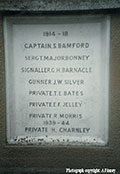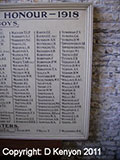Captain Edwin Scott Bamford
- Batt - 1
- Unit - York and Lancaster Regiment
- Section -
- Date of Birth - 23/04/1885
- Died - 24/04/1915
- Age - 29
Add to this record?
If you have photographs, documents or information that can contribute to this record, you can upload here
ContributeSource: Michael Doyle Their Name Liveth For Evermore: The Great War Roll of Honour for Leicestershire and Rutland. He was the youngest son of the late Arthur John Bamford, and his wife Annie Bamford, born 1854 in Balemen, USA (who remarried Captain the Honourable Harold Brooke Hawke), she was the daughter of John Nash of Chicago, USA. Edwin Scott was born in 1887 in Bromborough, Cheshire, he had one sibling, a sister Anne Nash Bamford, born 1889 in Bromborough, also residing with the family was Edwin’s cousin Mary Anne Gretton, born 1868 in Middlesex, in April 1891 the family home was at Bryn Marfyeed, Church Lane, Llanrhaiadr in Kinmerch, Ruthin, Denbighshire, Wales. In March 1901 Edwin was absent from the family home at Misterton, Hall, Misterton, Lutterworth, Leicestershire, residing there was his widowed mother, living on her own means and Edwin’s aunt, Sarah Ann Smith, born 1855 in Hanbury, Staffordshire, Edwin was residing as a boarder at Uppingham School, Stockerston Road, Rutland. Edwin married Lulu in London on the 1st January 1913, she was the only daughter of the late Edwin Whitney Smith of Bath. Edwin was educated at Uppingham, Rutland and later in Switzerland and joined the 3rd (Militia) Battalion of the Leicestershire Regiment from which he transferred into the York and Lancaster Regiment on the 6th July 1907, becoming Lieutenant on the 1st February 1909. In that year he passed the Signalling Course at Poona, India and obtained a certificate for Field Telephoning. In 1911 he took the Musketry and Machine Gun Course at Satara, India and in 1912 the Physical Training and Swordsmanship at Poona where he was Gymnastic Superintendent for eight months, serving altogether seven years (1908-1914) in India. On the 12th March 1913 he was appointed as the Battalion Adjutant with which he joined the British Expeditionary Force in France in January 1915. He had been promoted to Captain on the 5th September 1914, and was mortally wounded in action on his birthday, the 23rd April 1915 during a charge at the second Battle of Ypres, and died at the Poperinghe Clearing Station the following day. The following abbreviated account of the circumstances attending his death was received from a brother officer: “On the morning of April 22nd the Battalion was resting – the men playing football – when the French troops came hurrying back completely overcome by asphyxiating gases. Immediately, on their own initiative without any command, our men fell in and moved off by companies from the trenches near St. Jean, with fixed bayonets across open country in broad daylight, with only two guns to support them, to fill in the gap left by the French, which the Canadians were unable to protect with their flank. They made the attack through a hail storm of high velocity shell fire and Machine Guns at short range, which nearly wiped out the whole Battalion, leaving 300 out of the original 1200. In spite of the heavy casualties, they pushed on, as a Canadian officer remarked. “As if they were on parade,” and eventually reached a field which was under still heavy fire. At the top of the field was a hedge on which the enemy’s fire was concentrated, very few of the Battalion got past it. It was here that the Colonel was killed outright, and Captain Bamford having done magnificent work during the whole attack, was mortally wounded.” Some days after General Plumer came to see the few survivors and congratulated them on their gallant attack. Had it not been made the Germans would have broken through. To use the General’s own words. “They had saved the situation.” Captain Bamford was a keen sportsman and a first class shot. Other sources give the date of his death as 23th April 1915.
The War Diary records: 22 Apr-15 – HUTS near YPRES. 6.00pm. Very heavy firing heard to the North. 7.00pm. French troops came down all roads in great disorder saying the Germans had advanced overwhelming them with asphyxiating gases. The Battalion “Stood to.”
The War Diary records: 23 Apr-15 – HUTS near YPRES. 1.15am. Orders were received from 28th Division to move Battalion to ST. JEAN and there to come under command of Colonel GEDDES the BUFFS. Battalion left camp by Companies in the following order. “B” “D” “A” “C” with intervals of 300 x between. On arrival at ST. JEAN we heard 2 kilometres of French trenches had been rushed. Battalion occupied some trenches to North of ST. JEAN. While the BUFFS, 5th KING’S OWN, 3rd MIDDLESEX tried to join up the gap made in the line. ST. JEAN 5.30am. Battalion ordered to move forward and take up a post North West of WIELTJE (See Appendix 16). During this movement which was executed by small detached parties the Battalion experienced a severe shelling by shrapnel and high explosives causing a few casualties. The Battalion dug itself in, in some disused trenches and was heavily shelled most of the morning. Near ST. JEAN. 4.00pm. Orders were received for Battalion to participate in an attack on the German position. (See appendix 17). Near ST. JEAN. 4.05pm. Orders were issued by Commanding Officer to Company Commanders. (See appendix 18). Near ST. JEAN. 4.10pm. Companies marched independently to the farm and the attack -?- from behind it under very heavy rifle and machine gun fire. (See appendix 19). “A” Company moved off first followed by “C” Company. On arrival at hedge B Lieutenant CHAMIER was sent forward with No.’s 1 and 2 and Captain PALMER with 2nd Lieutenant CONNORS followed with No.’s 3 and 4 platoons close behind. No.5 platoon under Captain COWLEY moved off with “A” Company having become detached from “B” Company before the attack started. At about the same time “C” Company moved out to the right of “A”, No.’s 11 and 12 platoons leading under Captain EARDLEY-WILMOT and Lieutenant BRISCOE followed by No.’s 8 and 10 platoons under Lieutenant GAUNTLETT. “A” and “C” Companies were followed by “D” and “B” Companies also moving to small parties as far as hedge A. Here “D” Company followed the line of “A” at about 250 x distance in the following formation :- No.’s 13 and 14 platoons under Captain COLLINS and Lieutenant KENT-LEMON followed by No.’s 16 and 15 under Lieutenant BOYD and 2nd Lieutenant BATTLE. “B” Company followed the line of “C” Company, No.7 platoon leading under 2nd Lieutenant GIBBS followed by No.6 and 8 under Captain EAST and Lieutenant PARRY. During the advance of the infantry and after the last two Companies had passed hedge A, the machine gun section took up a second position along the hedge B where two Canadian machine guns were already in action. From this post the guns opened fire on the same ridge at 1000 x. The remainder of the country in front was so open that the guns were not advanced further until the fighting had considerably diminished and darkness had fallen when they were sent to the forward line in anticipation of a possible counter attack by the Germans. 8.00pm. Under cover of darkness Captain WEDGEWOOD who has assumed command of the Battalion decided that the Regiment had been so weakened that he could not hold such an advanced post. After consultations with officers of other regiments up there he decided to fall back and the Battalion dug themselves in along a position corresponding to the hedge A and continued to the left. Three machine guns were placed in position along this line and one in the farm behind. This had to be withdrawn on the following day owing to very heavy shell fire. The following were casualties in the weeks fighting:- Officers. Killed, Lieutenant Colonel A. G. BURT. Missing, Major H. J. COLSON, Lieutenant C. K. CHAMIER. Wounded, Captain EARDLEY-WILMOT, Captain A. E. PALMER, Captain R. B. COWLEY, Lieutenant A. L. KENT-LEMON, Lieutenant J. W. D. BOYD, Lieutenant K. S. BEDFORD, Lieutenant N. C. PARRY, 2nd Lieutenant D. CONNORS, 2nd Lieutenant H. W. GIBBS, 2nd Lieutenant E. C. BATTLE. Died of wounds, Captain and Adjutant E. S. BAMFORD. Wounded but at duty, Lieutenant B. C. LOUSADA. Other Ranks. Killed, 2 + 58. Wounded, 10 + 283. Missing, 2 + 82.
On Saturday May 8th 1915 The Leicester Chronicle and Leicestershire Mercury published the following article under the heading. “THE WAR.” – DEATH OF CAPT. E. S. BAMFORD. Captain Edwin Scott Bamford, adjutant of the 1st Battalion York and Lancaster Regiment, who has died of wounds, was the son of Mr. A. J. J. Bamford, of Misterton Hall, Leicestershire, and was in his 29th year. He was educated at Uppingham and in Switzerland, and was first commissioned in July 1907, and joined the 2nd Battalion (old 84th) at York. He left for India the following trooping season to join the 1st Battalion (65th), and came home at the end of last year to join a new division forming at Winchester for the front. Captain Bamford became Lieutenant in February 1909, adjutant March 1913, and Captain September 1914. He has served under four commanding officers, Colonel’s Scholes, Howe, Daniells and Burt. His late commanding officer, in giving up the command, said the adjutant had never spared himself in working for the efficiency and well being of the regiment.
- Conflict - World War I
- Cause of death - DIED OF WOUNDS
- Place of death - Poperinghe
- Burial Place - Ii L 39, Poperinghe Old Military Cemetery
- Birth Place - Bromborough, Cheshire
- Other Memorials - Misterton and Walcote - WW1, , Uppingham School Old Boys, WW1 Roll of Honour.
- Unit - York and Lancaster Regiment
- Cause of death - DIED OF WOUNDS
- Burial Commemoration - Poperinghe Old Mil. Cem., Belgium
- Born - Bromborough, Ches
- Place of Residence - Dhukrani, Herbertpur, Dehra Dun, India
- Memorial - ST. LEONARD'S CHURCH, MISTERTON AND WALCOTE, LEICS



